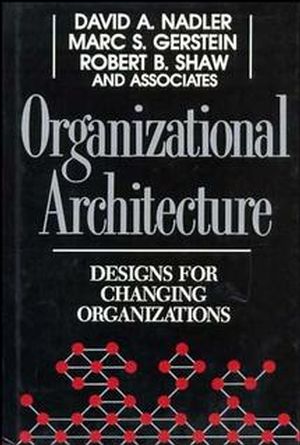Organizational Architecture: Designs for Changing OrganizationsISBN: 978-1-55542-443-5
Hardcover
304 pages
August 1992, Jossey-Bass
 This is a Print-on-Demand title. It will be printed specifically to fill your order. Please allow an additional 10-15 days delivery time. The book is not returnable.
|
||||||
Introduction: Organizational Architecture: A Metaphor forChange.
ARCHITECTURES OF CHANGE.
1. From Machine Bureaucracies to Networked Organizations: AnArchitectural Journey.
2. Designing Organizations That Have Good Fit: A Framework forUnderstanding New Architectures.
DESIGNING FORMAL ORGANIZATIONAL ARRANGEMENTS.
3. Managing the Dynamics of Acquisitions: Successfully Moving fromDecision to Integration.
4. Building Strategic Partnerships: Creating and Managing EffectiveJoint Ventures.
5. Designing High-Performance Work Systems: Organizing People,Work, Technology, and Information.
TRANSFORMING THE INFORMAL ORGANIZATION.
6. Implementing Total Quality Management: A Process of CulturalChange.
7. The Capacity to Act: Creating a Context for Empowerment.
8. Teaching Organizations to Learn: The Power for ProductiveFailures.
DESIGNING SENIOR MANAGEMENT.
9. Strategic Selection: Staffing the Executive Team.
10. Teamwork at the Top: Creating Executive Teams That Work.
11. Strategic Choice: Engaging the Executive Team in CollaborativeStrategy Planning.
THE ROAD FROM DECLINE TO COMPETITIVENESS.
12. Key Leverage Points for Improving CompetitivePerformance.
13. Organizational Architecture for the Twenty-First Century.
ARCHITECTURES OF CHANGE.
1. From Machine Bureaucracies to Networked Organizations: AnArchitectural Journey.
2. Designing Organizations That Have Good Fit: A Framework forUnderstanding New Architectures.
DESIGNING FORMAL ORGANIZATIONAL ARRANGEMENTS.
3. Managing the Dynamics of Acquisitions: Successfully Moving fromDecision to Integration.
4. Building Strategic Partnerships: Creating and Managing EffectiveJoint Ventures.
5. Designing High-Performance Work Systems: Organizing People,Work, Technology, and Information.
TRANSFORMING THE INFORMAL ORGANIZATION.
6. Implementing Total Quality Management: A Process of CulturalChange.
7. The Capacity to Act: Creating a Context for Empowerment.
8. Teaching Organizations to Learn: The Power for ProductiveFailures.
DESIGNING SENIOR MANAGEMENT.
9. Strategic Selection: Staffing the Executive Team.
10. Teamwork at the Top: Creating Executive Teams That Work.
11. Strategic Choice: Engaging the Executive Team in CollaborativeStrategy Planning.
THE ROAD FROM DECLINE TO COMPETITIVENESS.
12. Key Leverage Points for Improving CompetitivePerformance.
13. Organizational Architecture for the Twenty-First Century.



